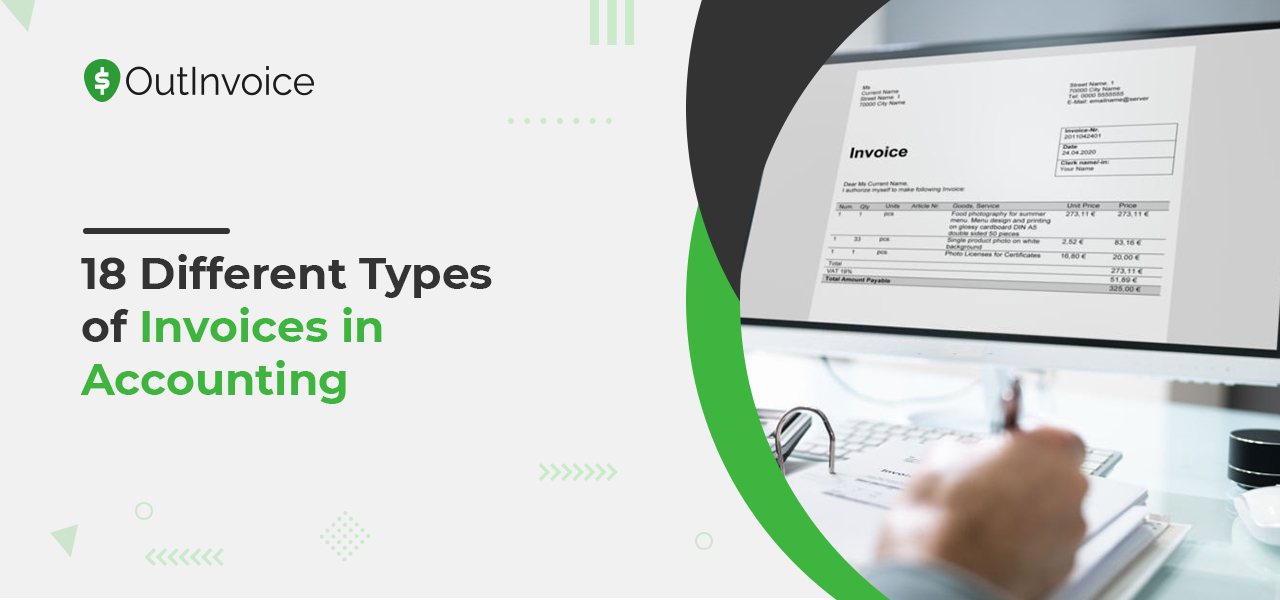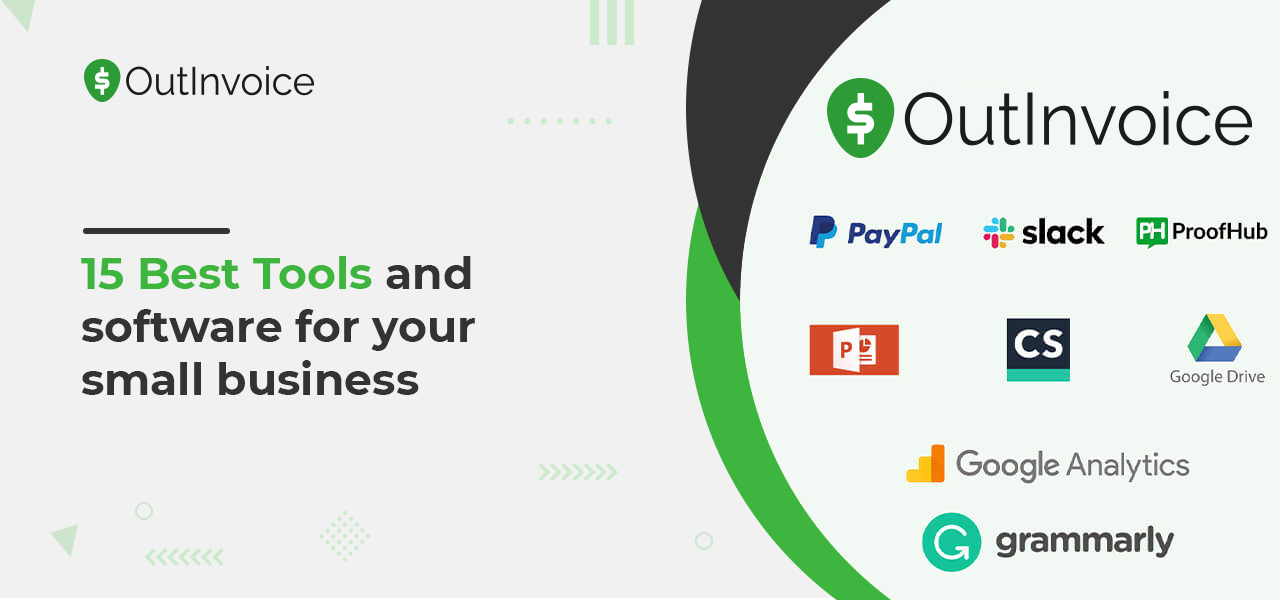
18 Different Types of Invoices in Accounting
There is various kind of invoices that you need to send according to the client and business. You need to know about the types of invoices, their utilization, and the kinds of invoices used. Each invoice has a specific purpose.
After providing services or products, small business owners send clients or customers invoices. The invoice reveals about service provided, how much is due when that payment is due.
As a business owner, you need to create, send, and pay them every month. Your invoices will differ depending on the industry, clients, products, or services.
For instance, if you are shipping products internationally, the regular invoice is not applicable. Instead, you need to know about other invoices like commercial invoices, including shipping costs and transport fees.
We will further discuss different types of invoices that fit best for your small business accounting.
While making an invoice, you should include the following information:
- Invoice date
- Customer or clients contact information like name and address
- Business information such as name and address
- Invoice number
- List of invoice items
- The quantity provided for each item measured in units, sometimes in hours
- The cost per unit
- Tax
- The total amount or invoice amount
- Invoice payment terms
Here are the things to consider while creating an invoice as each type of invoice has its objective. However, most of the invoices have some crucial information.
Date of Invoice: allows your client or customer about the day you created your invoice.
Customer Contact Information: You need to make sure to include all detailed information like customer name, address, contact number, business name, and contact number, and more on your invoice.
Item Purchased: Create a list of each product or service you provided along with their cost.
Total Due Amount: Mention the total due amount you expect to receive from the customer.
Payment Terms: Note about the expected day to be paid, payment methods the way the customer wants to pay.
For instance, what do you accept checks, credit cards, cash, or online banking? Is there a specific place customers should pay? Make the invoicing payment terms clean and clear, easily understandable by everyone.
Invoice number: Make a record of each invoice record for future reference.
Table of Contents
Different Types of Invoices in Accounting
It is essential to find the basic components of the different types of invoices.
1. Standard Invoice
The standard invoice is very much evident by its name. The standard invoice format contains information like invoice number, name of the vendor, company’s name, address, contain details, name of the customer’s name, address, item purchased, total cost, and more. The exact format can be used for different business transactions.
Many enterprises use standard invoices, and multiple companies line wholesale and trade industry, retail industry, agriculture industry, and more. These industries come across such invoices every day.
Generally, a Standard invoice is provided by the vendor to the client or customer. Standard invoice has many flexible formats for billing cycles and also a common form of an invoice. The standard invoice includes the following information:
- Invoice number
- Business name and contact information
- Clients details like name and contact
- Amount of money the client has for their business or service
2. Commercial Invoice
The commercial invoice is not a regular invoice that you receive from nearby shops or book stores; instead, it is a unique business invoice. They are designed for accurately shipping machine parts from one country to another.
Generally, it is used for customs declaration where products cross the border.
It comprises seller’s and buyers’ names and addresses, items sold, the cost of each item, total payable amount, and more.
The custom invoice must include particular information such as identification number, the origin of country, code for each item, proof of invoice authentication, the signature of in charge person, and more. It also includes some special notes and comments.
Commercial invoices include the following information:
- Shipment quantity
- Weight or volume of the product
- A detailed description of goods
- Total Amount
- Packaging format of the goods
- Country of origin
- Country of destination
- Shipment terms
- Signature of authorized personnel
3. Credit Invoice
A credit invoice is also known as a credit memo. It is an alteration to the previously provided invoice. It is used to acknowledge the business be in debt the buyer money. It is essential for the following situations:
- Your business does not follow the delivered services or goods on an invoice
- If products are damaged
- If the wrong products get delivered
- Pricing error
- If the client wants to return the product
A credit memo is made with a negative total number to correct the previous invoice. For instance, if you have to pay $100 as a refund, the total of the credit invoice will be -$100.
4. Debit Invoice
A debit invoice is also called the debit memo. It is used to levy a charge against a client. Sometimes you might underbill your client, and they needed correction by issuing the debit invoice.
For example, If you worked more hours on the project, you sent the invoice as per the previous agreement to create a debit invoice and send them for your extra hours.
Credit and debit memo is used to make adjustments for accounting and bookkeeping purposes. It is mainly used by small businesses and freelancers when they need to make modest reconciliation to the current bill.
For instance, if you send a client an invoice as per your estimated hours, you will work extra hours on a project. In this situation, you could send the client a debit invoice for the extra hour you worked. Debit invoices are non-negative numbers.
5. Mixed Invoice
The combination of debit and credit charges on one invoice is called mixed invoices. Mixed invoices can be expressed in positive or negative numbers.
Small businesses do not need to create mixed invoices. Small businesses only create a mixed invoice if you are cutting the amount a client owes for a project and increasing the total amount owed by the client, also included on the same invoice.
6. Timesheet Invoice
A timesheet is the type of invoice used by a business or employee to bill their invoices based on the hourly rate, which is the standard rate. It is mainly used by the contract employee who is paid hourly as per their work. It is also used in industries where customers are billed hourly. Some other organizations or companies who use this type of invoice are:
- Lawyers
- Creative or innovative agencies
- Business consultants
- Psychologists
- Tutors

Timesheet is a special kind of invoice that is a choice of professionals whose services are assessed on which services are provided. Generally, timesheet invoices are generated by an intelligent person rather than a technical. However, the employment of laborers is calculated hourly.
Timesheet mentions time instead of the product. If the items are rented, such as cars, cooking utensils, tents, costumes, cranes, and more, then these are charged in a time-based manner. It depends on how many hours you work.
A timesheet invoice includes distinctive elements like:
- Total hours worked
- Hourly rate
- Total days and days you started
- Administrative fees
7. Expense Report
An expense report is the type of invoice that the employer submits for the compensation of business-related expenses.
For example, if you send an employee for a meeting with the client, they will make an expense report to send to your company for their costs like lunch, bus fare, parking, and the gas they paid for.
8. Pro Forma Invoice
A pro forma is the type of invoice that the business sends to a client before providing service. It provides the estimated cost of the work before completion. They can be altered once the project is completed as per the working hours.
A Pro forma invoice also can be termed as an invoice that gives a rough idea to the client or buyer about the cost of products or services. It also referred to estimation or quotes.
This method is termed as the seller’s declaration expressing commitment to provide certain services or goods at the estimated price. Even a company may allow you to make the advance payment to the estimated project amount. Since it is not an actual invoicing format, it is not recorded accounts receivable or accounts payable.
9. Interim Invoice
It is the type of invoice where the business owner or vendor and the client agreed on standard terms that include multiple payments. A small business or freelancer will submit interim invoices when they complete some parts of the project.
For small businesses, interim invoices help to manage cash flow while working on a project.
10. Final Invoice
The final invoice is the ultimate invoice that is sent to the client after the completion of the project. It provides more detailed information than a pro forma or interim invoice. It includes the following information:
- The enumerated list of all services provided
- The total cost of the project
- Invoice number
- Invoice due date
- Payment method
The larger the project more you have to spend on supplies, operating expenses, labor, and more. To maintain cash flow in such a more significant project, you will use interim invoices. The company can pay on installment such that it reduces the burden on them too.
An interim invoice total amounts are divided into smaller payments. It is also called a progressive invoice.
For instance, let us assume that you are working on a project that lasts for ten months. To cover the cost, you will make an invoice ten times to start a project initially, at intervals to buy certain working utensils, and sometimes to pay an employee on a specific date and time.
It helps to reduce the risk of not getting paid on time, and you must not waste time wasting your time following them back.
You might prefer interim invoices to get paid on installment because of the following reasons:
Risks: Breaking it into installments minimizes your risk, and you didn’t need to worry about paying for a large project. It helps to maintain the cash flow. Even if you turned out to be a bad client with the interim invoice, the impact would be negligible to your business.
Cash flow: As the payments are coming in installments, you should not worry about the cash deficiency. It helps pay for your employee, tools, resources, and more.
11. Past Due Invoice
When the due date listed on the final invoice is exceeded, then a past due invoice is sent to the client from the respective vendors. As soon as you miss a payment due date, you should send past due invoices. It should include all the detailed payment lists on the final invoice. According to company rules, any late fees or interest charges are levied.
12. Recurring Invoice
Recurring invoice is mainly applicable for the rental industry where services or products are delivered at the end of each month. It includes house rent, tool rentals such as rent of a bus, or such items that need a specific time.
Recurring invoices are helpful for those businesses that charge the same amount regularly for their services. Recurring invoices are very usual among IT businesses that charge the same amount every month for a subscription package.
Also, if you are a freelance digital marketer, you might be provided with social media marketing packages to your customers with the best pricing per month.
Cloud-based invoicing software allows you to automate the whole process through recurring invoices each month.
A recurring invoice is sent to the same or recurring customer at regular intervals, containing the same invoice details. A recurring invoice is used for ongoing services. For example,
- A subscription plan for service, app, games, channels, etc
- Monthly or yearly plan for phone or cable
13. E-Invoice

E-invoice is a cover term applicable for any invoice sent electronically, in any case of the specific type of invoice being sent.
E-invoicing is the standard practice among small businesses and freelancers. E-invoices are quicker, faster, and easier to generate invoices using the standard invoicing template, and they help to get paid faster for your service or products.
An e-invoice includes all invoices that are delivered electronically, no matter what their type is. With the advancement in technology, the digitized method is gaining popularity day by day as it is a faster, easier, and convenient way to get paid.
It is the best alternatives to paper invoices. Technically, it is the best solution to get paid faster.
14. Utility Invoice
We barely think of electric bills, the bill for the telephone, internet usage, gas as an invoice; instead, it is a bill. It displays the amount payable on electricity usage or how much you be in debt to your internet connection provider for services.
Utility invoice comprises the due date, the amount of penalty payable after the due date, billing period, and more. It includes the previous amount or due.
15. Value-Based Billing
Value-based billing is the type of billing entirely based on the services or products provided to the customer. Value-based billing is entirely performance-based.
Value-based billing depends on the invoice amount and amount of work delivered to the client instead of the time taken to complete the project.
Value-based invoicing is client-based which depends on the needs, requirements, reckoning of the client.
16. Fixed-Bid Billing
Fixed-bid billing is the best fit for projects with well-defined requirements. If the requirement is stated, that makes it easy to determine the cost of the overall project.
Small businesses or freelancers are benefitted from fixed-bid-billing. A client can put a fixed price for the project before the project started or after completing the project. However, this type of billing is much profitable for small startups as it helps to workflow and timely payment.
17. Time-Based Billing
Some business will fulfill their particular service within an hour, and some may take 3 to 4 days for any work. Is it fair to get paid similarly? Definitely no! In this situation, time-based billing is the best choice. If you get the perfect hourly rate, then you can earn for each second.
Through time-based billing, you can find the actual value of the project. For creative works where you cannot ensure the time taken for the project completion, it is the best billing method.
Although there are diversified invoices, creating them should not be a brawl as you can always use online invoicing software and create professional-looking invoices in seconds. It has time tracking features that help to find the exact time you spent on a particular project or task.
18. Progress Invoice
Progress invoice is generally used for work that extends over a long period. Generally, it is used by construction lines like this industry that takes a lot of time for completion and is relatively expensive.
Contractors send the progress of the work mentioning quotes, the amount required to be paid in the form of invoices or bills. As they have to for the employee working for them covering expenses made during the ongoing project.
Conclusion
As there are different types of invoices, you must know the importance and difference between these invoices. The invoices you issue can depend on the products and services you offer and the payment terms you’ve agreed upon with your clients.
But there are many cases where delays in payments are occurred due to incorrect invoices sent to the clients.
Thus, it is always a good strategy to invest in robust invoicing software that helps you to perform accounting professionally. OutInvoice can be the best option for any small business and freelancer to efficiently create, send, and manage invoices.
You can signup and check out the 30 days free trial of OutInvoice and use all the features without using a credit card. It can be the perfect solution if you’re looking for a simple yet powerful and cost-effective billing and invoicing system.



